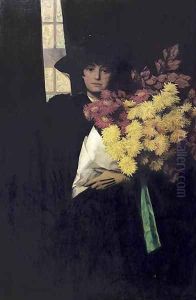Charles Henry Malcolm Kerr Paintings
Charles Henry Malcolm Kerr was a British artist known for his contributions to late 19th-century art, particularly in the realm of watercolor painting. Born in 1858, Kerr’s life was situated within the Victorian era, a period of the United Kingdom's history marked by the reign of Queen Victoria and characterized by significant industrial, cultural, political, scientific, and military changes within the United Kingdom.
Kerr demonstrated artistic talent from a young age, prompting him to pursue formal art education. He studied at various art institutions, which during that time, included prestigious schools like the Royal Academy Schools. His studies would have focused on the classical foundations of art, including drawing from casts of sculptures, studying anatomy, and mastering the techniques of oil and watercolor painting.
During his career, Kerr became proficient in watercolors, a medium that gained substantial popularity in Britain during the 19th century. This was a time when the British watercolor tradition had matured, becoming a respected artistic practice rather than just a preparatory tool or sketching method. Artists of this period were known for their delicate handling of the medium and their ability to capture the luminous quality of light and landscape with translucent washes of color.
Kerr’s work would have been influenced by the major art movements of his time, including Romanticism, with its emphasis on emotion and individualism, as well as the Aesthetic Movement that valued beauty and design. His subjects likely included landscapes, rural scenes, and possibly historical or literary themes, which were popular among the Victorian audience.
Despite his evident skill and the quality of his work, Charles Henry Malcolm Kerr did not achieve the same level of fame as some of his contemporaries. The late 19th and early 20th centuries were a time of great transformation in the arts, with the rise of movements such as Impressionism, Post-Impressionism, and eventually Modernism. These evolving tastes may have overshadowed the work of artists like Kerr, who were working in a more traditional manner.
Kerr's career spanned several decades, during which he would have exhibited his work at various venues, including the Royal Academy of Arts exhibitions, which were and remain a pinnacle of achievement for artists in the UK. His works may have also been shown in galleries and salons, and possibly collected by patrons and art enthusiasts of the time.
Charles Henry Malcolm Kerr's life came to an end in 1907. Though he may not be widely recognized today, his contributions to the art world during his lifetime added to the rich tapestry of Victorian art. His paintings, if they survive, would serve as a window into the aesthetics and values of a bygone era, capturing the beauty of the natural world as well as the artistic endeavors of the time.
